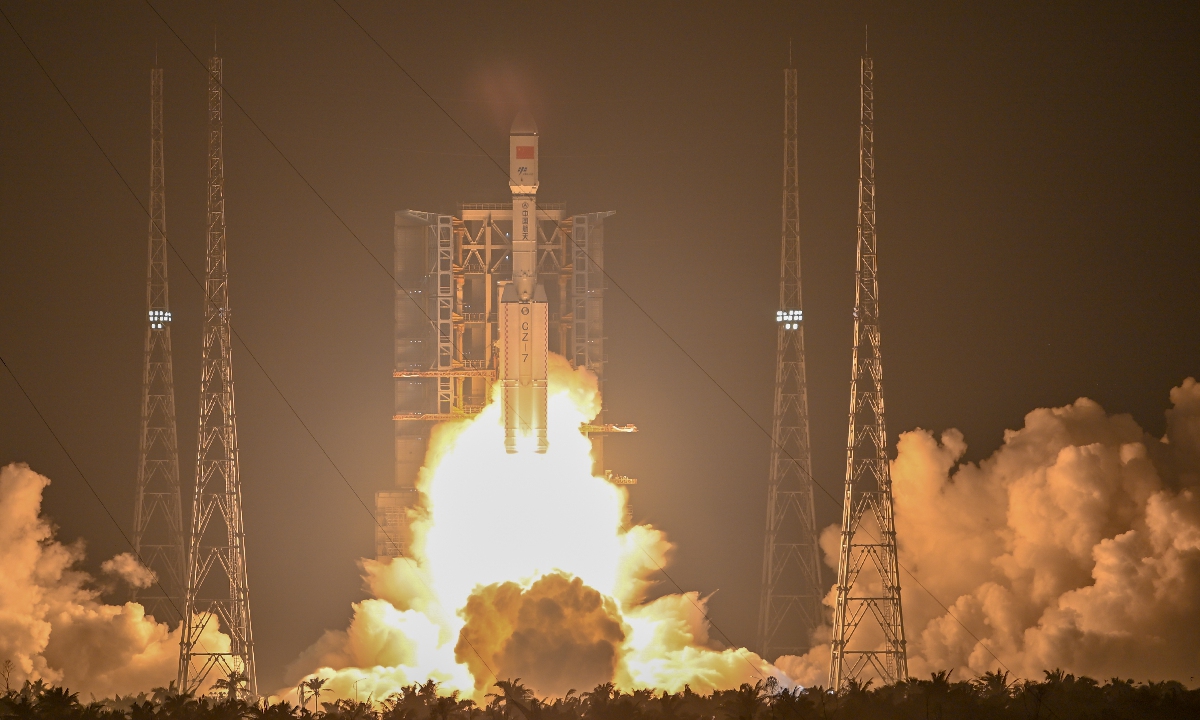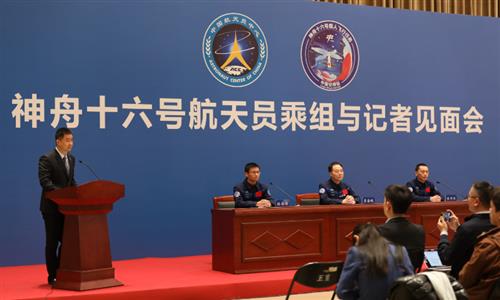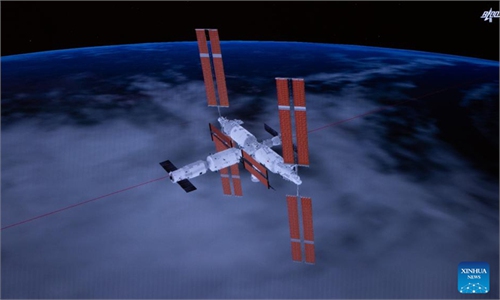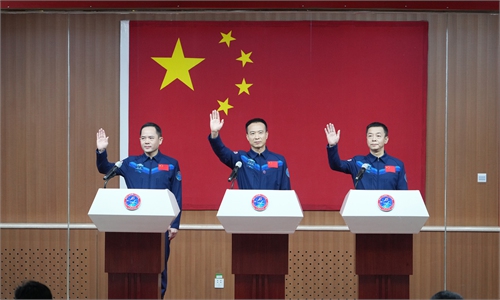
Tianzhou-8 cargo spacecraft blasts off from the Wenchang Space Launch Site in South China's Hainan Province on November 15, 2024. Photo: VCG
Carrying essential life supplies and experimental samples including those for future lunar base missions, the Tianzhou-8 cargo spacecraft blasted off from the Wenchang Space Launch Site in South China's Hainan Province at 11:13 pm on Friday aboard the Long March-7 Y9 carrier rocket.
About 10 minutes later, the Tianzhou-8 successfully separated from the rocket and entered its designated orbit. Subsequently, the spacecraft's solar panels were successfully deployed, marking a complete success for the launch mission, the China Manned Space Agency (CMSA) said.
The Tianzhou-8 is loaded with supplies for taikonauts' in-orbit stay, propellant, experimental devices, and other materials. It also delivered New Year gifts for the Shenzhou-19 crew in celebration of the Year of the Snake.
The mission marked the last one in 2024 heading for China's space station, drawing an end to this year's manned space program launch schedule.
Tianzhou-8 is the largest operational cargo spacecraft in the world, with the most comprehensive in-orbit support capabilities. The previously launched Tianzhou-6 and -7 already increased the loading capacity compared to earlier spacecraft of the series.
Tianzhou-8 further increases the cargo capacity by over 200 liters and more than 100 kilograms, the Global Times learned from the China Academy of Space Technology (CAST), a company affiliated with the state-owned China Aerospace Science and Technology Corporation.
However, the increase in capacity is not the biggest highlight of Tianzhou-8, said Dang Rong, deputy chief designer of the Tianzhou cargo series. "The enhancement for loading temporary cargo is even more noteworthy," she said.
"Our research teams have created a sliding rail that allows us to first place items that were originally stored in the refrigerator inside, and once everything is packed, we can push the rail to utilize the new space for some temporary cargo. This has increased the craft's temporary loading capacity from a few dozen kilograms to over 100 kilograms," Dang noted.
This will enable taikonauts to have access to more fresh fruit and vegetables, as well as further expanding the capacity for loading low-temperature experimental samples, thereby enriching the scientific experiment projects available in orbit, CAST said in a statement sent to the Global Times.
The space application system led by the Chinese Academy of Sciences (CAS) has sent 36 space science experiments and over 80 products, weighing approximately 458 kilograms, to the space station aboard Tianzhou-8, the CAS revealed.
These experiments cover various fields, including space life sciences and biotechnology, space materials science, microgravity fluid physics and combustion, as well as new technology experiments for space application.
Notably, this mission will carry "lunar soil bricks" for the first time, which are made from special materials that simulate lunar soil. These bricks will undergo space exposure experiments at the space station to verify whether they can be used for building structures on the moon. After completing the experiments, the first brick is expected to return to Earth by the end of next year, CCTV reported.
After entering orbit, Tianzhou-8 will use a three-hour rapid autonomous rendezvous and docking approach and connect with China's Tiangong space station at the aft port of the core module, forming an integrated structure, according to CAST.
Since the first autonomous rendezvous in 2011, when Shenzhou-8 docked with Tiangong-1 after 44 hours, China's docking technology has seen continuous advancements. In 2017, Tianzhou-1 docked with Tiangong-2 using a 6.5-hour fast docking model. In 2022, Tianzhou-5 set a world record with a 2-hour ultra-fast rendezvous, and in 2024, Tianzhou-7 validated the 3-hour model.
Tianzhou-8's docking will mark the establishment of a standard operational mode for future missions. While not the fastest, the choice of 3-hour docking has taken into consideration all factors more comprehensively, Kang Guohua, a senior member of the Chinese Society of Astronautics and professor of Aerospace Engineering at Nanjing University of Aeronautics and Astronautics, told the Global Times.
The mode integrates the "speed" factor from the 2-hour plan and the "reliability" factor from the 6.5-hour plan, successfully elevating China's space supply delivery to "express delivery," according to Kang. This demonstrates strong adaptability to meet the needs of different missions, making it an "optimal solution." The 3-hour mode also eases demands on rocket orbit conditions, measurement and control precision, and guidance accuracy, thereby boosting both flexibility and dependability for mission execution.
The Tianzhou-8's launch had previously been delayed due to Super Typhoon Yagi. It was the strongest typhoon that hit the Chinese mainland in autumn on record, making two landfalls in Hainan Province in September.
Based on previous practices, normally it is the cargo resupply that first arrives at the space station and then the new crew. However, due to the typhoon, the Tianzhou-8 mission, which was intended to arrive before the Shenzhou-19 taikonauts, is the first to reverse such common practice.
Wang Ya'nan, chief editor of Beijing-based Aerospace Knowledge magazine, told the Global Times that the delay of the launch mission has little impact on the taikonauts' lives, as there is always a buffer of supplies left in Tiangong before the next cargo arrives, ensuring there will be no shortage of materials due to delays. However, the delay may have some short-term impacts on certain experiments, particularly those that rely on specific experimental equipment.



